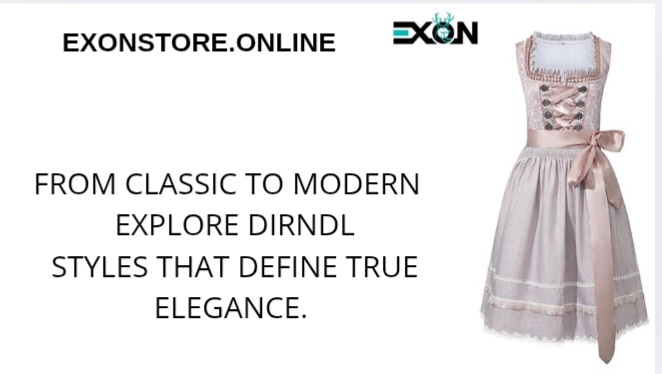The dirndl dress is more than just a piece of clothing; it is a cultural symbol, a statement of tradition, and an embodiment of feminine beauty.
Originating in the Alpine regions of Germany and Austria, the dirndl has a history that dates back centuries.
Today, it stands as one of the most recognizable forms of traditional attire in Europe, celebrated both for its cultural meaning and its timeless fashion appeal.
From its modest beginnings as a work dress to its status as a fashionable outfit worn at cultural festivals and weddings, the dirndl continues to hold a special place in the hearts of women worldwide.
Its charm lies in its ability to combine practicality, elegance, and heritage into one unforgettable garment.
The History of Dirndl Dresses
The story of the dirndl begins in the 19th century, when women living in Alpine villages needed clothing that was practical, durable, and suited for daily work.
The word “dirndl” originally referred to “young girl” in German, and over time, it came to be associated with the attire they wore.
Early versions of the dirndl were simple, made of sturdy cotton or linen fabrics. They typically consisted of four main parts: the bodice, blouse, skirt, and apron.
Each element served a purpose—blouses were lightweight and breathable, bodices provided structure, skirts were wide enough for movement, and aprons protected the dress while working.
As the years passed, the dirndl became associated less with labor and more with regional pride and identity.
By the late 19th and early 20th centuries, wealthier families and urban communities began wearing dirndls as festive attire. This transformation elevated the dress from its humble origins to a symbol of elegance and tradition.
Cultural Significance of the Dirndl
The dirndl dress is not merely worn for fashion; it carries deep cultural symbolism. One of the most fascinating aspects is the tradition of the apron knot.
The placement of the knot on the apron communicates a woman’s relationship status:
- Left side – The woman is single.
- Right side – She is taken or married.
- Front center – She is a bride or possibly a virgin.
- Back – She is widowed or works as a waitress.
This unique code gives the dirndl a storytelling element, allowing it to speak without words.
Beyond this, the dirndl has become a central piece of Bavarian celebrations, especially at Oktoberfest, where women wear them with pride to honor cultural traditions.
Modern Adaptations of Dirndl Dresses
In today’s fashion world, dirndl dresses have evolved while retaining their classic charm. Designers have introduced variations that blend tradition with modern style.
Traditional dirndls often feature earthy tones, intricate embroidery, and cotton or linen fabrics.
In contrast, modern versions may include silk, satin, lace, and even bold color palettes such as deep reds, midnight blues, or pastel shades.
Shorter hemlines, stylish necklines, and glamorous fabrics have made the dirndl popular not only at cultural events but also at weddings, themed parties, and fashion shows.
This versatility allows the dirndl to appeal to younger generations while still honoring its historical roots.
Another modern adaptation is the customization of accessories. Women pair dirndls with jewelry, shawls, and hats to personalize their look.
Some even mix traditional styles with high heels or trendy handbags, proving that the dirndl can be both classic and contemporary.
Why Women Love Dirndl Dresses
The dirndl has remained popular for centuries because it flatters women of all shapes and sizes. Its fitted bodice and flowing skirt create an elegant silhouette, while the apron adds a touch of charm.
The dress highlights femininity in a way that feels both traditional and stylish.
Moreover, wearing a dirndl connects women to their cultural roots. Even outside of Bavaria or Austria, women across Europe and beyond wear dirndls to celebrate Oktoberfest or themed events.
This global appeal has given the dirndl a place in modern wardrobes while keeping tradition alive.
The Dirndl in Global Fashion
The influence of the dirndl has gone beyond Bavaria. International designers have taken inspiration from its structured bodices, lace-up details, and feminine skirts. Fashion enthusiasts often incorporate dirndl-inspired elements into contemporary dresses, proving its lasting influence.
The global popularity of Oktoberfest has also spread awareness of the dirndl, with women from all corners of the world embracing this attire as a way to experience Bavarian culture. The dress, once limited to Alpine regions, is now a celebrated fashion choice across continents.
Conclusion
The dirndl dress is not just a garment—it is a cultural treasure that represents heritage, identity, and timeless beauty.
From its beginnings as a simple work outfit in Alpine villages to its modern adaptations on global fashion stages, the dirndl has continuously evolved without losing its essence.
Its cultural significance, especially the apron knot tradition, adds depth and uniqueness, making it more than just attire.
Whether worn at Oktoberfest, a wedding, or as a fashionable statement, the dirndl connects women to history while celebrating femininity.
Ultimately, the dirndl is a perfect example of how tradition and modern fashion can coexist. It continues to inspire designers, flatter women of all body types, and symbolize the charm of Bavarian culture.
With its lasting elegance and cultural pride, the dirndl dress will remain an iconic outfit for generations to come.







